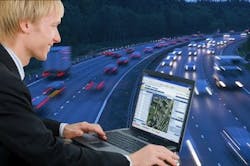Telematics Puts Managers In the Driver’s Seat
Every technological advance throughout human history has ultimately had one central purpose: making life easier. Telematics for construction equipment is no different. The goal is to streamline and simplify the process of tracking your fleet and keeping it in tip-top shape. With a few clicks, fleet managers can see where their equipment is, what it’s doing, and what condition it’s in.
A survey conducted by the Association of Equipment Management Professionals (AEMP) on telematics usage, sent to 101 individuals, sheds some light on the current state of the technology. More than half, 57 percent, say they don’t use telematics to manage their fleets, and 63 percent say less than 10 percent of their off-road fleet is equipped with telematics
“Many of the very large contractors have already created or worked with equipment manufacturers to develop APIs,” says Randy Jaminet, customer support manager for John Deere. “The next group that may not have the IT resources internally are trying to learn more about what their opportunity is to get it done.”
The first decision is where to buy the technology. Deere, Caterpillar, Komatsu and Volvo offer telematics systems as a standard feature. There are also third-party telematics providers that can fit a fleet with a system.
Both OEM and third-party products offer a wide array of tracking and management tools. One feature common across numerous systems is geofencing. It allows fleet managers to create invisible, electronic boundaries around a piece of equipment, designating a specific operating area. If the machine moves outside of that boundary, an alert is automatically sent to the fleet manager. This helps deter improper use and/or theft of a company’s machines. Some providers, such as Volvo, offer a timefence as well; this allows users to designate specific hours of operation for a machine. If it is activated outside of those hours, an alert is triggered.
“Given the state of the economy, I think there’s more opportunity and more concern over theft in the marketplace,” says Mike Baker, vice president of sales, North America, for Navman Wireless. “People are being more cautious as to where they’re leaving their equipment.”
Boundaries aren’t always about theft prevention. With DPL America’s Jobsite Boundary tool, users can draw custom “regions of interest” on a map; any machines in that boundary are automatically assigned to that area, making checkups at particular jobsites quick and easy.
Many providers also offer mobile access to telematics data. ZTR Systems’ Near Me application is one example. Fleet managers can see all of their equipment mapped out while receiving alerts and fault codes in real time right to their phone.
“There’s an increasing expectation that information is available and at any time,” says Brent Horne, product engineering manager for ZTR. “Smartphones themselves can be considered telematics devices and will play an important role in creating and viewing telematics data, thus increasing connectivity to fleet assets, users and site conditions.”
Telogis has entered the mobile market as well with the Telogis Mobile application, which integrates fully with the company’s Fleet and Route systems. “We wanted to give mobile workers the ability to connect with the back office,” says Sean McCormick, product manager for Telogis Fleet and Telogis Mobile. “It extends their ability to get more real-time information.”
Although many of these solutions look at the machine as a whole, there are other devices that examine specific functions or parts. Fleet managers focused on fuel consumption can utilize the new Multi-Pump Tracker from OEM Data Delivery, which examines fuel levels and up to seven other consumables. Engine maintenance becomes easier with devices such as OEM’s ST-570 RFID Hour Meter or the Engine Hour Meter from SkyBitz.
A number of providers also offer on-road telematics solutions for the lighter equipment. One example is the Skyhawk Vehicle Tracking System from DPL, suitable for trucks, cars and any other such equipment. It fulfills many of the same duties as its off-road counterparts, tracking vehicle position, idle time, and maintenance scheduling. Trimble’s GeoManager can even evaluate drivers by monitoring aggressive driving behavior and hours of service logs.
“I think what we’re really starting to see as a trend,” says Baker, “is people trying to get to the understanding of what telematics can do for them in a basic format.”
